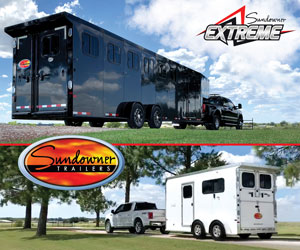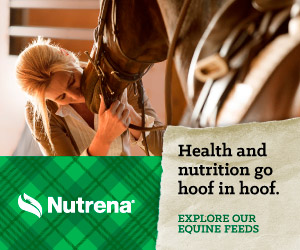THE ART OF FIRE & STEEL

One small project picks out an inside look into the life of a farrier.
By Larri Jo Starkey
My left hand grips the long tongs tightly, keeping my half-horseshoe steady on the anvil. I lift a hammer and take careful aim at the red-hot end.
Pong.
My weak blow changed nothing on the red-hot end. My second blow – still too weak – also bounces off the quickly cooling project.
Apparently, I can’t hurt steel by hitting it with a hammer.

Larri Jo Starkey
My first attempt was a disaster.
I receive this revelation as if it’s new, then stuff my project back into the forge, right into the middle of the burning coal pile, heat from the fire lighting my dissatisfied frown.

My mama has always said I could give lessons to a donkey, and I have determined that the piece of iron I am trying to turn into a hoof pick will become a hoof pick today, one way or another, so I dig through a stack of tools to find a heavier hammer, one that will make a real impact.

Larri Jo Starkey
My completed project is ugly, but it’s mine.
Fortunately for me, I have a guide for my mulish determination.
Master blacksmith Craig Trnka has been a farrier for more than 35 years. For the past five years, he has shod horses only with shoes he has created himself. He appeared on the second season of the TV show “Forged in Fire” and founded World Championship Blacksmiths, a group that has as its motto “To inspire excellence through education within the farrier industry.”
In short, he’s an expert.
I need him on this journey into the art of the forge.
Creating the Object
When Craig demonstrated making the combination hoof pick and bottle opener, the whole process took 10 minutes, max.
From the time I bellied up to the anvil until project completion … well, let’s not get ahead of ourselves.
The first step is cutting a horseshoe in half. Craig has already done that part. He has a stack of half shoes ready for the group of us six neophytes. We have arrived at his home in Edgewood, New Mexico, just outside Albuquerque, to learn a little more about one of the world’s oldest practical art forms.
With the head start Craig has given us, we’re supposed to flatten one end so that it’s thin enough that we can punch a hole through it. Then, we’ll start making that hole wider on the horn of the anvil, heating the steel and gradually “wallowing” it into a wide-enough oval to fit over a bottle cap.

rebecca dider
My left arm is feeling more tension than my right arm at this point. The next day, I will not be able to close either hand around a glass without remembering my forge work.
My hammer taps gain rhythm, and I can see the hot steel spreading out and thinning. When I punch through the steel, I let out a happy yelp. This is gonna be great, I think.
That’s when I overheat the steel and, with one semipowerful blow, crack the piece into uselessness.

I stare at it in horror and no small amount of befuddlement. I have actually managed to break steel.
Craig laughs and slaps another half horseshoe in my hand. I’m not sure I’m worthy of the trust, but I gamely stuff it into the forge and start over.
Temperature control of the steel and the forge is one of the challenges blacksmiths must master. Craig uses a coal fire, but other farriers choose propane to heat their forges.
After the initial thrill of using the tools wears off, my arms – unaccustomed to this exercise – inform me that they would rather I try short sessions. It’s not my right arm with the hammer that’s feeling the stress – it’s my left arm, the one holding the piece. I’m terrified of dropping my project on the floor, and my forearms tense rigidly as I hold as tightly as I can.
I drop the piece anyway, and its clang is a loud reproach. I scramble in embarrassment and barely remember in time that I shouldn’t pick the piece up with my hands, but with the tongs.
Fire is hot, you know.

Larri Jo Starkey
Master blacksmith Craig Trnka demonstrates how he creates horse shoes from bar stock.
Out of necessity, my forge partner and I start using smaller and smaller taps and overlapping them more. We’re learning to use the anvil to help us and to make more efficient blows – just as Craig said we should.
As Craig explains it, the project we’re making is an essential building block of the trade for farriers, from flattening the steel to punching it to drawing the steel out to working on all the parts of the anvil.
“Everybody has $20,” Craig says. “And after you make and sell a few $20 hoof picks, you’re building skills and you’re building a clientele.”

While we work, Craig shares aphorisms on topics from horses to blacksmithing and the importance of a balanced diet and exercise program.
“Motion is lotion,” he says. “Farriers aren’t competing against others but against their own bodies.
“I was born to be a farrier, but not all people are exposed to it. I think TV shows like ‘Forged in Fire’ have increased the interest in blacksmithing for young people.”
Craig bounds from group to group, quickly rescuing project after project with casual skill gained through years of repetition.
I continue hammering. It’s a cool day, and when I started my project, the fire from the forge was warmly comforting. Now, sweat gathers on my back, darkening my T-shirt. When I think the hole I’m creating is wide enough, Craig places an awl-like tool right on the inside bottom edge of the hole.
Conscious that I could accidentally hit Craig, I give the awl a little kitten pat with my hammer.
“Try again,” he says, so I do, firmly, and we create the “lip” that will be wedged under a bottle cap.
I stare at it in wonder. I have created a bottle opener. I douse it in the water bucket by the forge and it hisses, steaming as it cools. I pull it out and stare at it some more. I have created a bottle opener from fire and forge.
I put the other end of the piece into the fire and while it heats, I run around with my arms over my head, yelling, “I made a bottle opener!”
This is so satisfying.

I feel the thrill of creativity and accomplishment that farriers must feel with every hoof – and there’s still the hoof pick to go.
When I finish that, I attempt to burnish my hoof pick/bottle opener on a grinder, but my uneven hammering has left dips in the project that won’t sand smoothly. I do not care that this is possibly the ugliest hoof pick ever made. It is mine.
“Blacksmithing is an art,” Craig told us at the beginning of the day. “What you make isn’t going to look like what the person next to you makes.”
He was absolutely right.
Larri Jo Starkey is senior editor for AQHA Media. More information on Craig Trnka’s World Championship Blacksmiths is at www.worldchampionshipblacksmiths.com.
How to Find a Farrier
The United States has no regulatory process for farriers.
“People can flunk out of a trade school one day and become a farrier the next,” says master blacksmith Craig Trnka. “My goal is to increase farriers’ skills, like the apprentice programs in the United Kingdom.”
An index card pinned to a bulletin board at the feed store might be advertising a good farrier who wants the best for your horse – or it might not, Craig says.
He has two bits of advice.
First, look for a member of a trade organization, such as the American Farrier’s Association, an AQHA educational alliance partner.
Second, ask farriers – casually! – about their ongoing education. Farriers who intend to improve their craftsmanship will continue to take classes or compete in farrier contests such as Craig’s own World Championship Blacksmiths.
And Craig points out one kind of farrier to absolutely avoid: “You don’t want a farrier who’s available the next day. That means he’s so new he doesn’t have any clients or he’s so terrible he doesn’t have any clients.”

